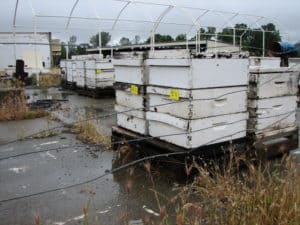Beekeepers are farmers. And like other types of farmers, beekeepers depend. on the weather. And this was a particularly stressful year for weather. Queen season started out with temperatures much lower than normal and rainy in February and March. The problem with the poor weather is the queens that normally would go out and mate did not have a single day nice enough to fly, resulting in beekeepers not being able to cage mated queens to sell. The queens had to wait two weeks until they could mate, putting the bee breeders two weeks behind their normal schedule. They had to push queen orders back, creating a huge demand for queens. Most of the customers seemed to understand the circumstances as well and that there was nothing the bee breeders could do. Actually, everything in the bee breeder’s control went especially well this year: colonies looked great coming out of winter, huge going into almonds, and they produced drones early. But without the weather cooperating, the season was rough and stressful. Now it’s the end of May and still about 10 degrees cooler, we are still getting some rain, and there have been multiple tornado touchdowns (although only very minor, especially in comparison to the devastation in Missouri). I’ve been told May would be in the 80-90’s, I basically wouldn’t see rain from April to September, and tornados don’t happen. At least the cool weather has let the beekeepers run a later breeding season than normal to help make up for some of their losses in the beginning of the season.

Northern California summers are supposed to be brutally hot and dry. People talk about their summers here like Minnesotans talk about their winters. If kept in small colonies (like nucs) where temperature regulation is difficult, the bees will abscond. The trick is to start raising queens just before the 70 weather hits in late February or early March and finish by the end of May beginning of June. There are some breeders that continue producing queens on a much smaller scale throughout the summer and part of fall, but move their colonies out of the brown, dry land to produce honey in the Midwest or to pollinate crops in Oregon or Washington. I am still waiting for the heat to come.